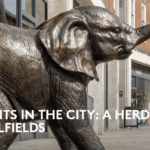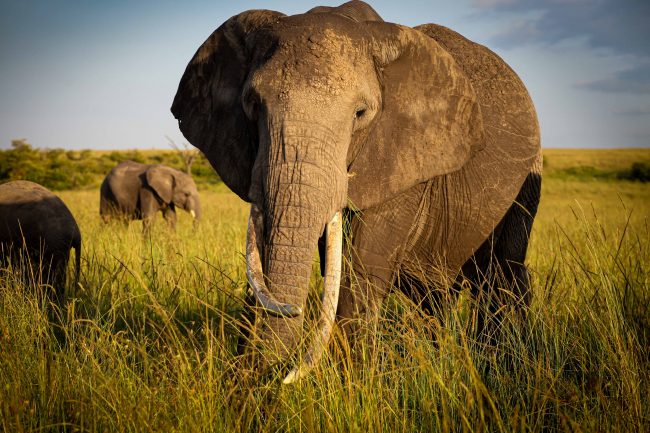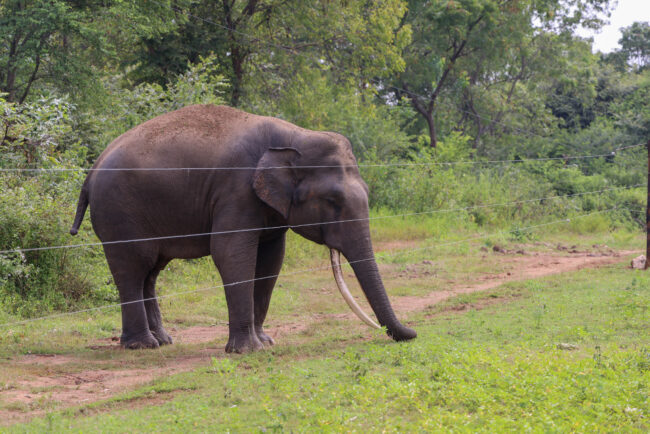During August 2024 on her World Elephant Day tour to Kenya, Patricia Sims, the founder of World Elephant Day (WED), had the opportunity to visit Mara Elephant Project (MEP) in the Lemek Conservancy and the Maasai Mara. While she was there she met the incredible MEP team and experienced some of their groundbreaking conservation work. Three young women in particular stood out.
Often referred to as the “3Ss,” Sarafina Sironka, Sharon Murumbi, and Sylvia Nyarangi are blazing trails, not only for elephants, but for the next generation of women conservationists in Kenya and beyond.
As part of the MEP team, they are contributing to innovative work on the frontlines, including the development of ElephantBook, a digital conservation tool often dubbed the “Facebook for elephants.” In regions where conservation hasn’t traditionally been seen as a path for women, these three are changing the narrative. Their leadership, brilliance, and commitment make them role models for young people everywhere — especially girls dreaming of a future in wildlife protection.
Young women conservationists like Sarafina, Sharon, and Sylvia are exemplary inspirations behind the creation of World Elephant Day’s Emerging Storyteller Fund, a new initiative supporting grassroots conservation, and youth-led storytelling that transforms awareness into action.
Their leadership is a reminder that storytelling isn’t just about sharing facts — it’s about passing on wisdom and inspiring action. The Emerging Storyteller Fund will mentor and uplift young storytellers across elephant range countries, helping their voices carry the legacy of the matriarchs into the future and help spark a new generation of conservationists. In Kenya and beyond, young women will see what’s possible and know that they can do this too.
We caught up with the 3Ss and asked them to tell us about their inspirations, their challenges, and their goals:
How It All Began
Sarafina:
“I realized I wanted to pursue a career in conservation when I was still in primary school. Growing up in Narok [in Kenya], I was always surrounded by wildlife and nature. It was part of my everyday life. I remember going on school trips to game reserves, and seeing elephants, giraffes, and other animals in the wild really stayed with me. It wasn’t just exciting, it made me feel deeply connected to the natural world. What truly inspired me was seeing how wildlife and communities depend on each other, and how important it is to protect that balance. I knew then that I wanted to be part of something bigger to protect wildlife, support communities, and help create a better future for both.”
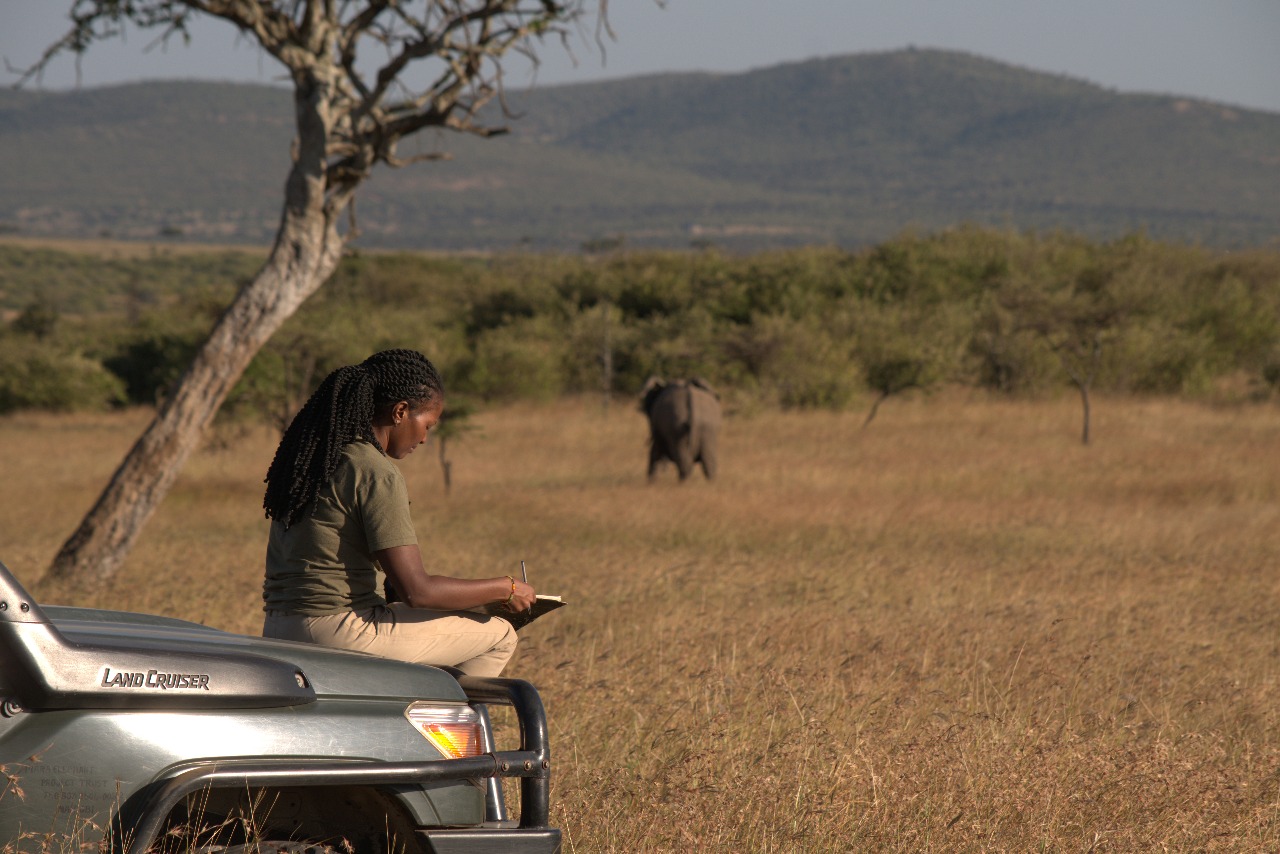
Sarafina Sironka tracking elephants for ElephantBook. Photo: Mara Elephant Project
Sharon:
“I have been passionate about nature since I was a young girl growing up close to wildlife. Seeing how human activities disrupted animals and their habitats. This inspired me to be part of the change in nature conservation. My inspiration always comes from the desire to protect our wildlife and ensure future generations can experience the same natural ecosystem I grew up with.”
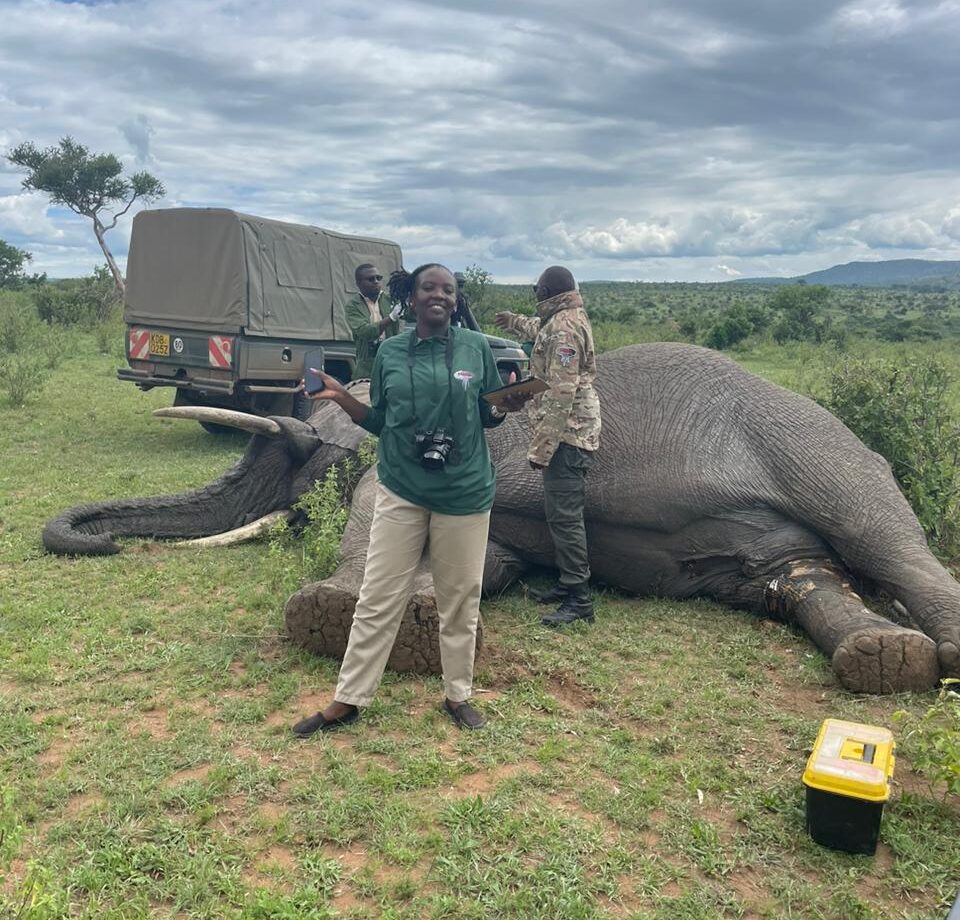
Sharon Murumbi working at Mara Elephant Project, next to a sedated elephant. Photo: Mara Elephant Project
Sylvia:
“Growing up, I wasn’t exposed to the world of conservation. In fact, there isn’t much wildlife in my home county. However, after enrolling in the Wildlife Research and Training Institute through the Government Universities and Colleges placement, I became curious and interested in conservation. I discovered a thrilling new world that I had been unaware of, and that marked my initiation into conservation. I’m so glad I chose this path, or should I say, the world of conservation chose me. The urge of wanting to keep the wildlife safe, make sure that future generations get to see the amazing and magnificent species, I am their voice and guardian, that’s my inspiration.”
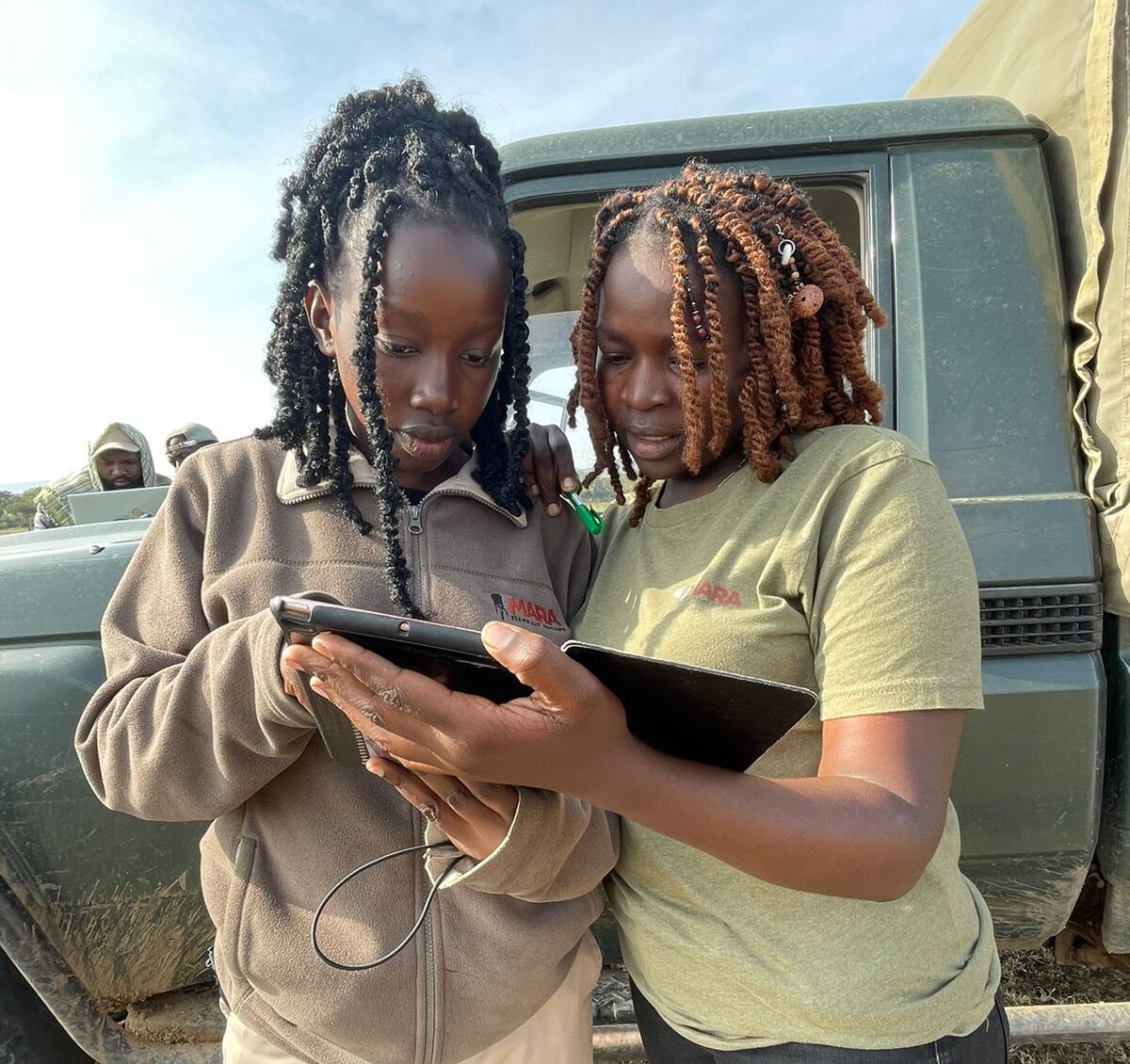
Silvia Nyarangi (left) collaborating with Mary, of Mara Elephant Project
The Challenges
Sarafina:
“One of the biggest challenges I’ve faced has been financial hardship. There were moments I honestly didn’t know how I would pay for my education or afford transport to attend important opportunities. It was frustrating knowing I had the passion and drive, but feeling limited by circumstances beyond my control.There were also times when I felt overwhelmed and unsure of myself. Starting out in the conservation field, surrounded by people with more experience, I sometimes questioned whether I was good enough or whether I really belonged in those spaces. I’ve had moments where I thought, ‘Maybe this is too hard’, or ‘Maybe I won’t make it’. But every time I felt like giving up, I thought back to the little girl in primary school who fell in love with nature. That memory kept me grounded. I also had people who encouraged me mentors, friends, even strangers who believed in me when I was struggling to believe in myself”.
Sharon:
“There have definitely been challenges. Being a young woman in conservation, especially in a community where conservation hasn’t always been seen as a “woman’s job”, hasn’t been easy. Sometimes people don’t take you seriously, and there are moments where you wonder if it’s worth pushing through. But every time I feel like giving up, I remind myself why I started. For the elephants, for the community and for the future generation. The challenges have always made me more determined.”
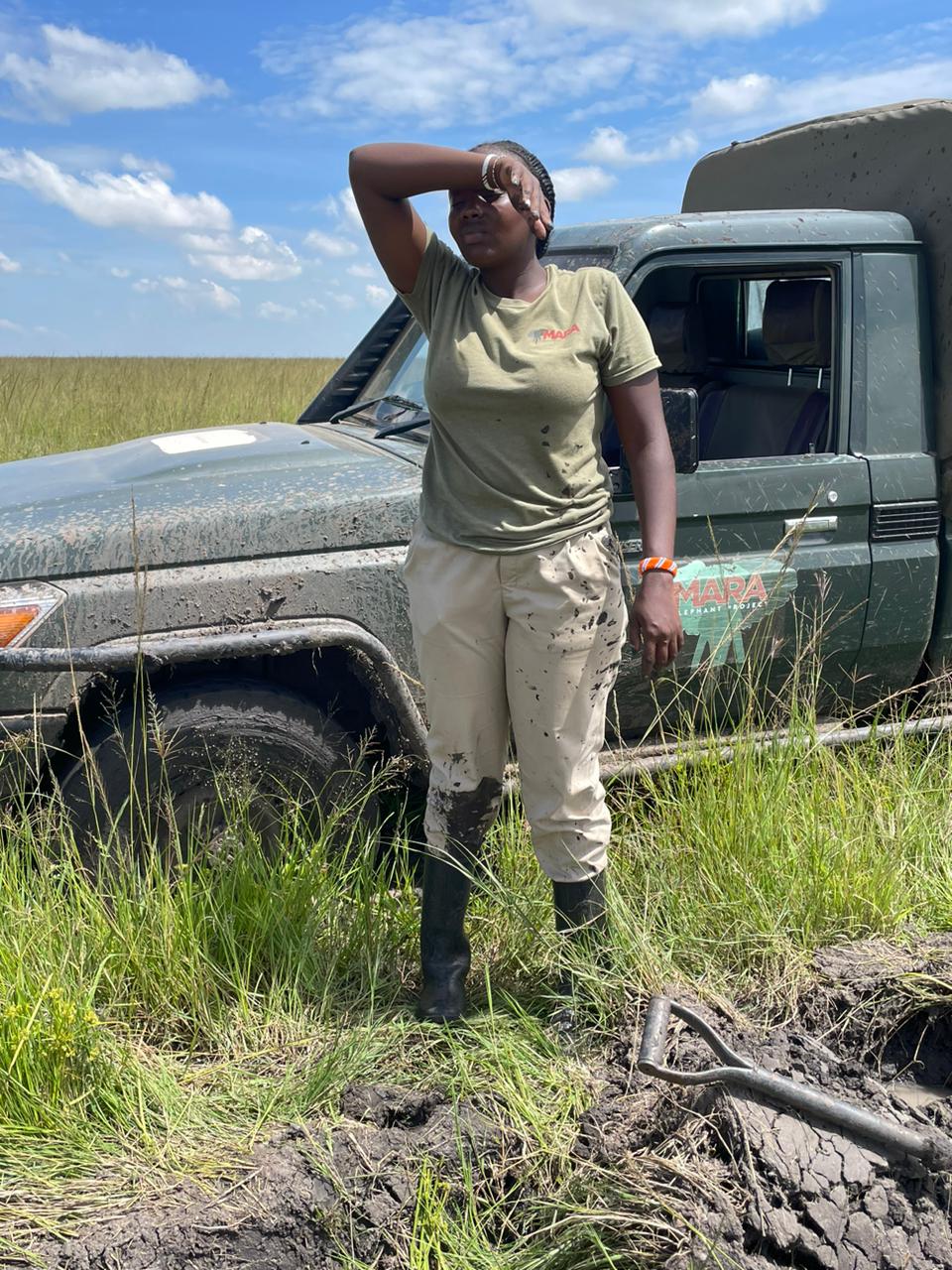
Sharon, at the end of a long day. Photo: Mara Elephant Project
Sylvia:
“Dealing with these magnificent, gigantic creatures can be overwhelming, especially the large bulls, as they can be aggressive, and I’m only human. There is also the emotional attachment to certain individuals; for instance, last year, we lost one of our big boys, Kegol, to old age. Another emotional incident was when a small calf died due to injuries sustained during birth; that was truly heartbreaking”.
Science, Technology and the Unravelling of ElephantBook
“ElephantBook is the elephant version of Facebook. According to the 2021 census, there are approximately 2,600 elephants in the Mara, and our database includes over 1,200 adult elephants, excluding calves and subadults. ElephantBook has been invaluable for documenting the family structure and composition of the elephant population”, says Sylvia.
“It’s designed to help us monitor, protect, and understand elephants better over time. The main objective is to support long-term conservation by allowing us to identify elephants accurately, track their movements, observe their behaviour, and respond to emergencies like injuries or human-elephant conflict.” explains Sarafina. “Some of the cool features include the ability to identify elephants using clear photographs from the left side, right side, back, and even profile view, capturing unique details like tusk shape, ear tears, holes in ears and other natural markings that help us to identify individual elephants.
“Every particular elephant on Elephant book has a unique ID. It is all about education and awareness. Its main goal is to help people, especially young people, to understand elephants better. Their behaviour, their role in the ecosystem, their families and how they relate, and understanding the population dynamics in The Greater Mara Ecosystem.” adds Sharon.
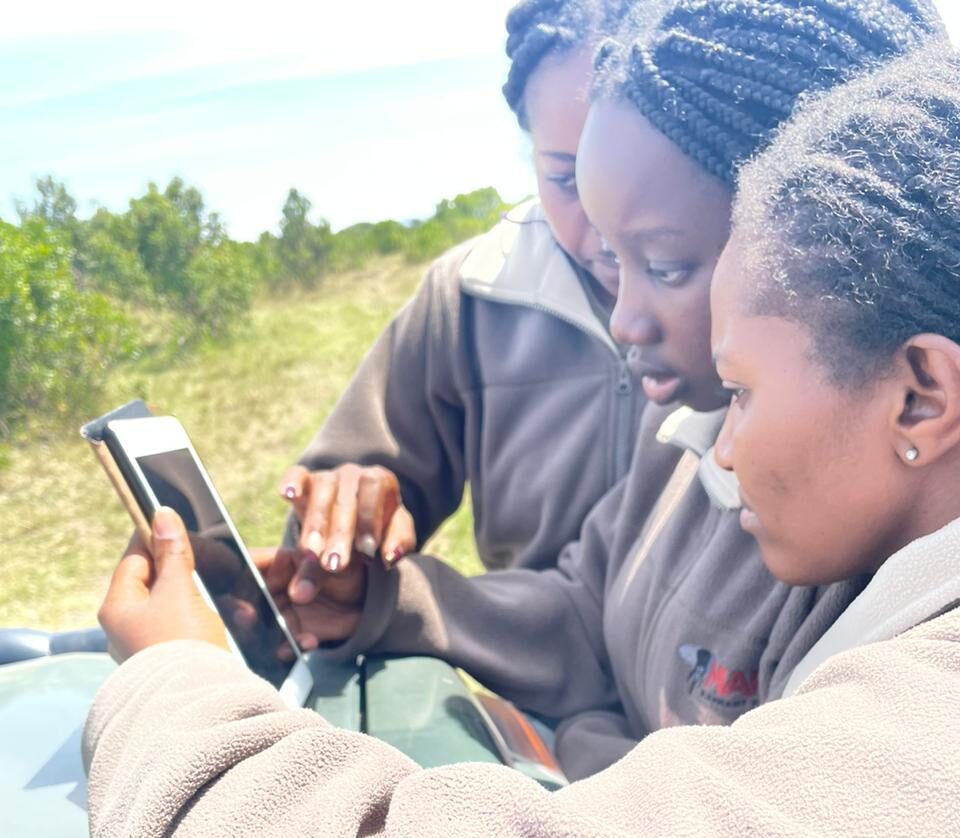
Sarafina, Sylvia, and Mara Elephant Project team member Carol, review ElephantBook. Photo: Mara Elephant Project
What Needs to Be Done for Elephant Conservation?
Sarafina explains that the critical problem of human-elephant conflict is caused by shrinking habitats. “The most important thing we should be doing for elephant conservation today is making sure elephants have safe spaces to live, while also working closely with the communities who share the land with them. The truth is, elephants are facing more pressure than ever, habitats are shrinking, and as they move in search of food and water, they sometimes come into conflict with people. And it’s not just hard on the elephants, it’s hard on the communities too. I really believe that conservation has to go hand in hand with community support. When people understand elephants, when they feel heard and included, and when they benefit from conservation efforts, they become protectors, not just bystanders. At the same time, we have tools now like tracking collars, the Elephant Book, and Earth Ranger that help us follow elephants, understand their patterns, and respond fast when something goes wrong. So to me, it’s about balance: using science and technology, but also building real, human connections between conservation teams and local people. That’s how we’ll protect elephants in the long run”.
Sarafina:
Conservation today needs to be both community-centered and technology-driven because elephants don’t just need protection, they need people who care, understand, and are willing to act.”
Sylvia:
Elephants are keystone species, so I can’t even imagine the devastating effects on the ecosystem if they were to disappear. As education, awareness, and sensitization efforts are increasing, coexistence should be prioritised. It is essential to maintain a balance between protecting both people and elephants without neglecting one for the other”.
Sharon:
I believe the most important thing is strengthening community involvement, this is because they understand the landscape way better than anyone else. Local people, me being one of them, really need to be part of the solution. We need to listen and involve them, create opportunities and create solutions that benefit both the people and elephants. Whether it’s through education, livelihoods, or better conflict management, communities should feel that they are part of conservation”.
World Elephant Day Connection
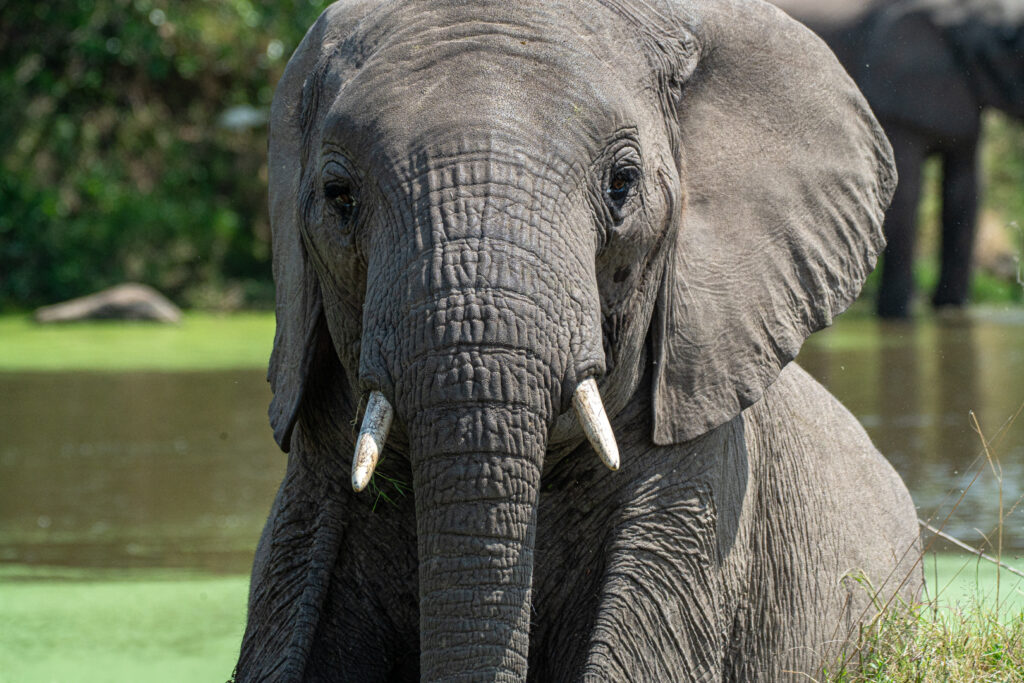
Patricia the Matriarch Elephant Photo: Patricia Sims
“My trip to Kenya for World Elephant Day 2024 was my first time in this amazing country. I can’t think of a better way to experience the Maasai Mara for the first time than to spend those days with Sarafina, Sharon, and Sylvia on the savannah, identifying elephants for ElephantBook”, says Patricia. “It was remarkable to witness the passion and dedication that these three women have for community-based elephant conservation”.
Needless to say, the admiration was mutual. Before her departure, Mara Elephant Project paid a tribute to Patricia and World Elephant Day by naming one of their matriarch elephants ‘Patricia’, in their ElephantBook database. At the time ‘Patricia the elephant’ was pregnant. Although they have not had any recent sightings of her, Mara Elephant Project believes she has given birth to her calf. “I was very touched and honoured that Sarafina, Sharon and Sylvia named an elephant after me for ElephantBook”, says Patricia. “I can’t wait for Part Two of this story! I hope to have the opportunity to visit the Mara again someday soon to see my namesake and her calf”.
Why Conservation Stories Matter?
Conservation stories breathe life into statistics and show the heart behind the science. By spotlighting local voices, especially those historically underrepresented, conservation storytelling builds empathy, shifts perspectives, and inspires action. We asked the “3Ss” what they think:
Sarafina:
“Sharing stories about the science and technology we use in conservation is so important not just for now, but for the future. When we tell those stories, real stories from the field, it helps people understand the impact of the work. It makes conservation feel real and possible. It also helps communities, donors, and even young students see how science and tech fit into protecting wildlife. These stories inspire the next generation. They show that you don’t have to be a ranger to make a difference; you can be a tech person, a data analyst, a photographer, and still play a big role in conservation. So yes, stories matter. They connect people to the work in a way that facts alone can’t. They help build support, spark curiosity, and most importantly, keep hope alive for the future of wildlife.”
Sharon:
“Stories are so powerful and relatable. Sharing how different technologies help in tracking elephants, reduce conflict and gather data to predict elephant movements, they begin to understand and appreciate conservation more. I feel like science might feel more distant to people and especially the locals, but stories make things real and engaging.”
Sylvia:
“By sharing these stories, we help the outside world appreciate these incredible animals, and some individuals even change their perceptions, moving beyond the idea that elephants are simply destructive. Additionally, our work and presence on social media offer glimpses to those considering their career paths.”
Since 2012, World Elephant Day has championed storytelling as a powerful force for change, uplifting the voices of rangers, researchers, Indigenous leaders, youth, and filmmakers.
If you’re passionate about community-led conservation, join World Elephant Day in amplifying the stories that make a difference. By donating to the Emerging Storyteller Fund, you’ll help mentor and support young storytellers in elephant range countries — those who carry forward the wisdom of elephants and the matriarchs who lead them.
These stories matter — and so does your support. Your gift helps emerging conservationists like Sarafina, Sharon, and Sylvia share their stories and create a safer, more compassionate future for elephants and the communities who live alongside them.
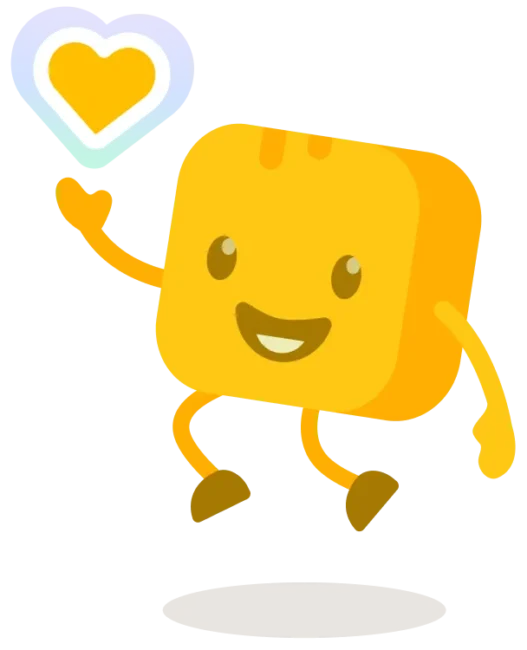 Please click here to donate today: https://givebutter.com/WED2025
Please click here to donate today: https://givebutter.com/WED2025
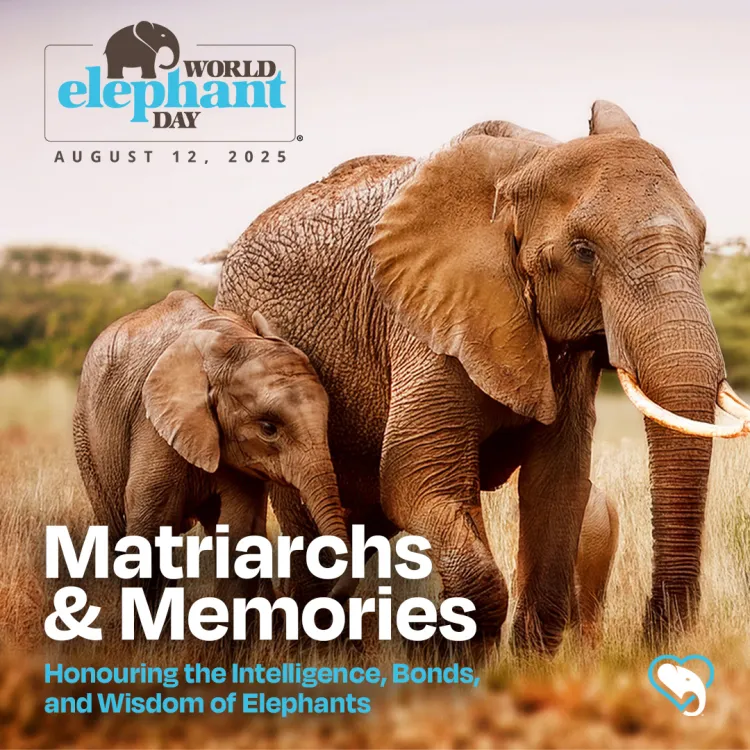
_____________________________________________________________________________________________
Written by Caleigh Campbell for World Elephant Day
Executive Director, Patricia Sims
Photos courtesy of Mara Elephant Project, dedicated to protecting elephants and their habitats in the Greater Mara Ecosystem of Kenya.
_____________________________________________________________________________________________
Sources:
- Interviews with Sarafina Sironka, Sharon Murumbi and Sylvia Nyarangi.
- Mara Elephant Project: A Gen Z Woman with a Heart for Elephants
- Mara Elephant Project: MEP Develops Elephantbook to Automate Identification of Elephants


